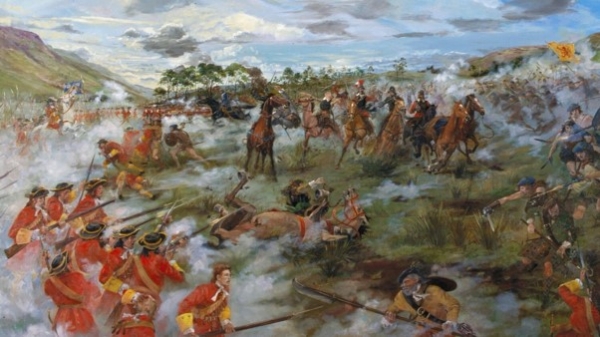National Battlefields Inventory does not afford Protection or Interpretation: those should be next steps
6th Biennial Battlefields Symposium November 20th looks forward to the vital next steps to take us all Beyond Designation
This was the sixth occasion that those who host many of the nation's 40 Designated Battlefields in Scotland have met to debate and agree on what vital next steps are required. The Symposium took place in The HES Engine Shed at Stirling and although originally established in Prestonpans with HLF support, it now convenes under the aegis of the Scottish Battlefields Trust.
Ten Years since the National Inventory was initiated
Yes, it's a decade ago that the SNP led Scottish Government resolved to take an Inventory of the nation's most significant battlefields and 40 are now listed and scoped. It's a task that has been extremely well executed under the leadership of Kevin Munroe at HES. It now affords the opportunity to identify very clearly what it is in the national interest to protect and interpret for current and future generations.
The Inventory per se however offers no protection from inappropriate development. Planning Policies at a national level simply require that local planning authorities must 'factor in' the reality that the Inventory's Designated Areas are the nation's significant battlefields whenever making any planning decisions. It is true that all such decisions must always be brought to HES' attention; as a Statutory Consultee under Planning Policies HES has the opportunity to lodge an Objection. But that's the extent of it and unwelcome and unnecessary planning decisions still override any battlefield's identified significance if locally deemed fit - see the debates over dualling A9 at Killiekrankie [letter below].
Our experience within 'Designated' Prestonpans has not been satisfactory to say the least!
Prestonpans has seen repeated instances where even the requirement to 'factor in' has been ignored as with the naming competition and interpretation for Blindwells/ Charlestoun; the deliberate cultivation of Brussels sprouts rather than rye on the battlefield; the construction anew at the SE corner of the battle bing; the public offer of the battlefield lands it owns to potential developers post Scottish Power's ownership; and most incredibly the construction of the inshore/ offshore access sub-station for the proposed wind farm directly on the known burial areas of the battlefield.
These Prestonpans experiences have been mirrored elsewhere at Culloden and Killiekrankie [pictured low] re the A9 dualling. Details of NTS future vision for Culloden were also shared and discussed.


If protection and interpretation are to be achieved new, hard, statutory powers and planning protocols are called for - and the Scottish Battlefields Trust has been pledged to that end since 2014
Following the debates and subsequent evaluation of the Symposium, what is now envisaged for debate is the Motion That:
1. All Designated Battlefields* must henceforth be treated as 'Areas Protected in the National Interest'.
2. Any and All proposals for development thereon will accordingly be unacceptable ab initio unless and until it can be demonstrated that there is a superior national interest at stake e.g. widening the A9 at Killiekrankie.
3. In all such circumstances as may be argued at 2. i.e. superior national interest, a Public Inquiry shall be held to ensure such is indeed justifiable and the results of that Inquiry shall be tabled with the Minister responsible for decision.
4. All such Inquiries shall specifically be required to explore whether the proposal made can be accomplished by alternative approaches i.e. outwith the specific proposal advanced.
5. In the event that a 'superior' national interest is adjudged to exist all reasonable efforts must be made to record and interpret the battlefield heritage that is necessarily sacrificed to that end.
Requirement for Host Community to Interpret its Battlefield
6. All host communities for the Designated Battlefields shall prepare and sustain a pattern of appropriate interpretation including the creation and /or maintenance of memorials and anniversary commemorations in accordance with Best Practice as advised and monitored by HES.[This is something we are well prepared to do for Prestonpans.]
Ministers in 2020 will be lobbied to consider and adopt this approach
If such a strategy is adopted the protection of battlefields will no longer be 'back foot rearguard actions' against a sequence of ad hoc development proposals - which is the current distressing and costly situation. It will be a coherent national strategy sensibly and successfully executed.

____________________________________________________________________
* The Designated Areas in the National Inventory embrace the widest scope of the battle normally including the surrounding landscape with routes of arriving and departing armies and their encampments. This means that on occasion the Designated Area includes a quantum of development either present at the time of the battle or created subsequently. Sometimes it may well have become extensively urbanised as at Langside and increasingly at Prestonpans.
Whilst this approach to designation by HES was highly commendable ab initio it may well be deemed that it will not always be appropriate to identify the entire Designated Area as to be forever protected in the national interest. This will undoubtedly be contentious and has been the subject of extensive debate from the outset. Is there an identifiable 'core area' that requires absolute hard protection and a balance that requires lesser protection - both in the national interest. It is perhaps best that this be resolved on a battlefield by battlefield basis as the issues at 6. above are addressed.
Published Date: November 27th 2019
|





